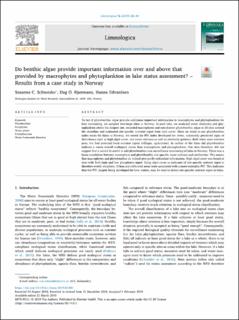| dc.contributor.author | Schneider, Susanne Claudia | |
| dc.contributor.author | Hjermann, Dag Øystein | |
| dc.contributor.author | Edvardsen, Hanne | |
| dc.date.accessioned | 2019-11-18T12:01:38Z | |
| dc.date.available | 2019-11-18T12:01:38Z | |
| dc.date.created | 2019-06-14T13:18:42Z | |
| dc.date.issued | 2019 | |
| dc.identifier.citation | Limnologica. 2019, 76, 28-40. | nb_NO |
| dc.identifier.issn | 0075-9511 | |
| dc.identifier.uri | http://hdl.handle.net/11250/2629019 | |
| dc.description | | nb_NO |
| dc.description.abstract | To test if phytobenthic algae provide additional important information to macrophytes and phytoplankton for lake monitoring, we sampled two large lakes in Norway. In each lake, we analyzed water chemistry and phytoplankton above the deepest site, recorded macrophytes and non-diatom phytobenthic algae at 20 sites around the shoreline and estimated site-specific nutrient input from land cover. Since no ready-to-use phytobenthos index exists for lakes in Norway, we tested the PIT index developed for rivers, commonly perceived signs of disturbance such as high algal cover, and taxon richness as well as similarity patterns. Both lakes were nutrient poor, but had potential local nutrient inputs (villages, agriculture). In neither of the lakes did phytobenthos indicate a worse overall ecological status than macrophytes and phytoplankton. Our data therefore, did not suggest that it would be useful to add phytobenthos into surveillance monitoring of lakes in Norway. There was a loose correlation between macrophyte and phytobenthic site-specific taxon richness and similarities. This means that macrophytes and phytobenthos do indeed give partly redundant information. High algal cover was found at sites with both high and low phosphorus input. Using algal cover as indicator of site-specific nutrient input is therefore overly simplistic. Urban and cultivated areas were associated with a more eutrophic PIT. This indicates that the PIT, despite being developed for lotic waters, may be used to detect site specific nutrient input in lakes. | nb_NO |
| dc.language.iso | eng | nb_NO |
| dc.publisher | Elsevier | nb_NO |
| dc.rights | Attribution 4.0 Internasjonal | * |
| dc.rights.uri | http://creativecommons.org/licenses/by/4.0/deed.no | * |
| dc.title | Do benthic algae provide important information over and above that provided by macrophytes and phytoplankton in lake status assessment? – Results from a case study in Norway | nb_NO |
| dc.type | Journal article | nb_NO |
| dc.type | Peer reviewed | nb_NO |
| dc.description.version | publishedVersion | nb_NO |
| dc.source.pagenumber | 28-40 | nb_NO |
| dc.source.volume | 76 | nb_NO |
| dc.source.journal | Limnologica | nb_NO |
| dc.identifier.doi | 10.1016/j.limno.2019.02.001 | |
| dc.identifier.cristin | 1704992 | |
| cristin.unitcode | 7464,30,19,0 | |
| cristin.unitcode | 7464,20,18,0 | |
| cristin.unitname | Ferskvannsøkologi | |
| cristin.unitname | Miljøinformatikk | |
| cristin.ispublished | true | |
| cristin.fulltext | | |
| cristin.qualitycode | 1 | |

